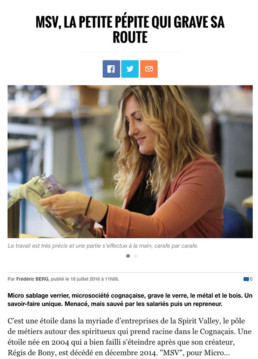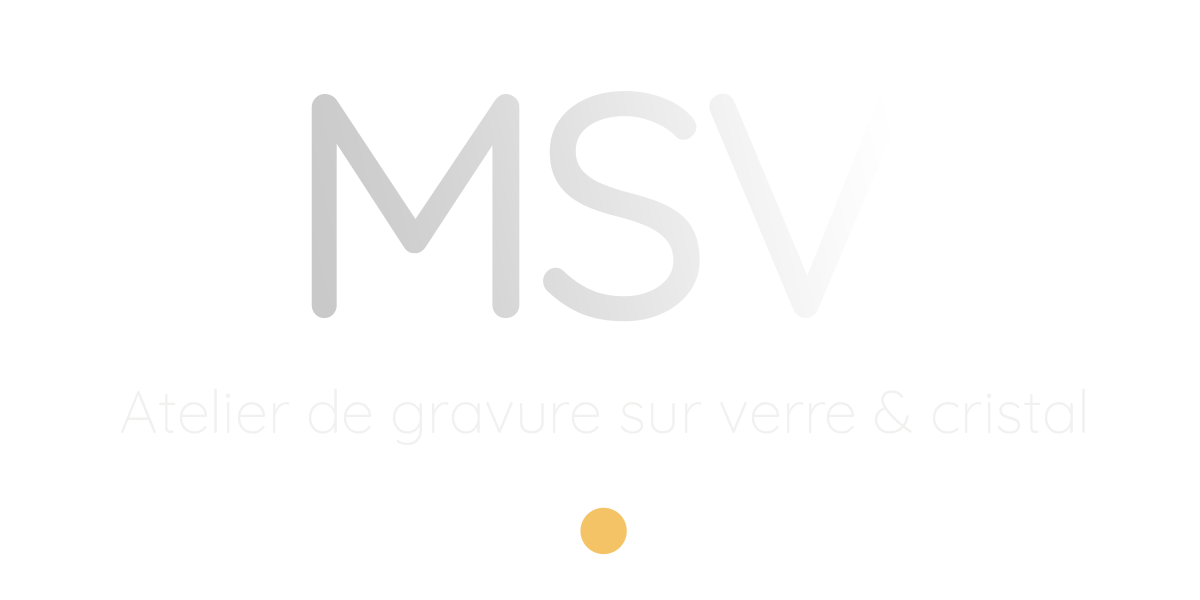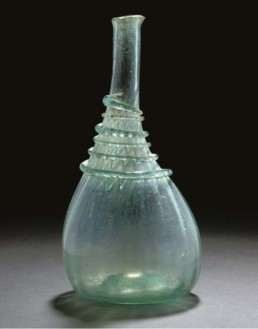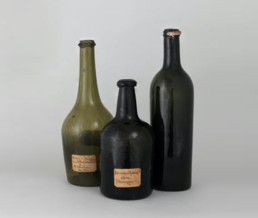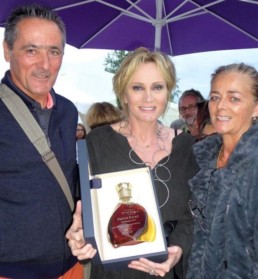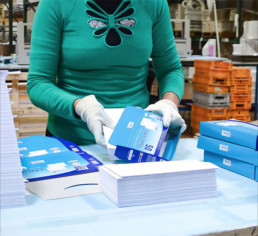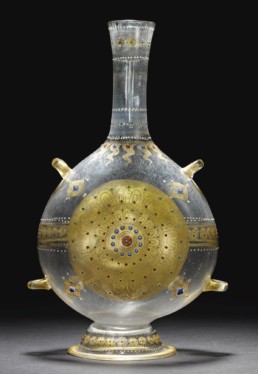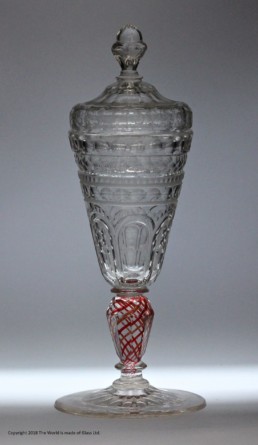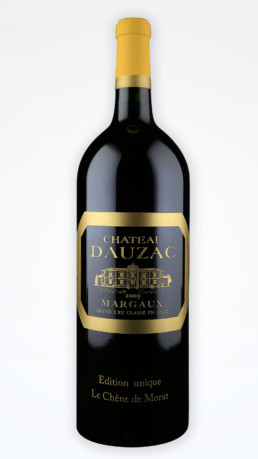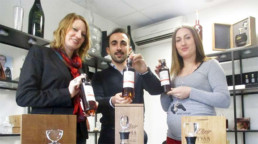History of the Glass Bottle
The bottles of the great cognac houses are one of the most spectacular supports in glass engraving. However, the bottle was hidden for a long time or too fragile to be engraved. Focus on this discreet and yet elegant glass object!
Laborious Beginnings
It was not enough to master glass or crystal to see the birth in glass workshops of superb bottles useful as much in the service of water as that of alcohol. The glass was fragile and the possibilities of making the closure of the bottle almost non-existent. Nothing very engaging for the conservation of wines. Especially since the latter, until the 19th century, quickly turn to vinegar, it is therefore absolutely necessary to consume it within six months of the harvest.
During Antiquity and the Middle Ages, the bottle was therefore not yet used for conservation and it was preferred to serve on table.
The Orient, absolute master of glass art, supplies the Mediterranean basin with elegant decanters and bottles of beautiful translucent glass, and sometimes colored, but not yet perfectly transparent. But as we move into the Middle Ages, Europe forgets the intricacies of this ancient technique. Decanters and bottles, which have become fragile and dull, hide in clissages or leather cases which protect them from inevitably fatal shocks. If the most luxurious productions are distinguished by glass caps, most can be closed with a simple piece of fabric and care must therefore be taken to transport them vertically at the risk of dispersing the contents!
It is in part this necessary precaution as well as the technical knowledge of the time that are responsible for the ancient and sometimes comical shapes of these medieval bottles. Spherical and flattened, onion or pear shaped, bottles and decanters straight out of our history books also served as gourds and their shapes, as far as the glassmaker was then capable, were copied from the shapes of the decanters and silver flasks.
Yet in the Orient of the same period, the same glass objects are still of remarkable quality, far superior to those then made in Europe. In the 17th century, moreover, Persian wine from Shiraz was transported in superb bottles of colored and solid glass when our European wine had to adapt to barrels.
European Innovations
An English invention of the 1640s will profoundly change the history of the bottle and in particular that of wine conservation.
While developing a thick black glass in a London workshop, an English eccentric by the name of Kenelm Digby (1603 – 1665) surely did not take the measure of his invention. Thanks to this opaque glass capable of protecting the container from light, a first step is taken towards better conservation of the wine. A few years later, the rediscovery of the cork marks a further step in the history of the bottle. From now on, the risks of breakage are minimized but above all the dark glass and the cork make it possible to preserve the wine, impossible until then. As long as the ideal conditions are met in the cellar, a bottle of wine can now age without the risk of turning to vinegar. Better! Aged wine develops particular aromas.
The formerly pot-bellied shapes are lengthening and becoming truncated thanks to this new black glass, more malleable and solid, facilitating transport in crates and announcing the disappearance of transport in barrels …
British connoisseurs and great lovers of Bordeaux wines use their invention to easily transport the wine productions they bring back from the southwest of France and taste in England. We even know an Irishman who, in 1723, opened a glass factory in the Chartrons district of Bordeaux. He thus supplies the wine merchants of the district, who naturally find their account there: the wine is protected in an opaque, well-sealed bottle with a guaranteed capacity to avoid fraud. If already in England, the bottles are starting to be stamped with the name, the coat of arms of their owner or the year of the cuvée, in Paris this revolution of gourmets is underway!
Under the Empire, the elites are now reluctant to buy in barrels, preferring the bottles that the new Russian-style service allows to be displayed on the table. That of Joséphine de Beauharnais and especially her cellar in Malmaison are a brilliant illustration of this new way of consuming wines.
The Bordeaux bottle, also known as Frontignan – with a great future – was born at this time. Glass art then took on a considerable scale. Since glasses, decanters and bottles are now placed on tables and no longer on sideboards along the walls, it is in the best taste to get hold of sumptuous objects in crystal or in Bohemian cut glass and engraved with fashionable patterns or the owner’s monogram. One likes to observe and discuss the color of the wine in his glass but the bottles must imperatively remain dark and opaque for obvious reasons of conservation.
Spirits’ bottles do not have the same requirements as bottles of wine. Cognac, armagnac, whiskey, gin or rum age in barrels for many years before they can be enjoyed. Once sufficiently patinated by time, it is no longer necessary to keep them away from light and their bottling can then be the subject of aesthetic attention. Because the beauty of the colour often plays an important part in the tasting. The choice of connoisseurs naturally goes to exceptional and unique bottles and decanters.
MSV has thus distinguished itself as the benchmark partner of the great wine and spirits houses: bespoke engravings, exceptional bottles and presentation boxes place your wines and spirits at the center of attention, offering them an unprecedented scale. .
Do you have a project on glass or crystal? An event to celebrate? Contact us and let’s discuss it!
MSV's gift to Patricia Kaas
The MSV company collaborated with Cognac Paris to offer Patricia Kaas a carafe for her concert at the Barbezieux Fair.
This engraved carafe containing a cognac grande Réserve 1er cru delighted the star who agreed to pose with his box.

MSV's gift to hard rock band Trust
On July 29, 2017, the French hard rock group Trust performed on the banks of the Charente for the 20th edition of the Fête du Cognac.
To celebrate this tour “In the name of rage” crowning 40 years of career, the group was offered a decanter worthy of the event!
The MSV company is proud to have taken part in this gift in collaboration with Cognac Paris.
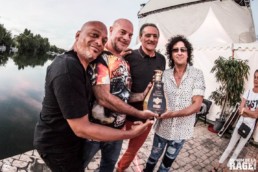
A big thank you to the Trust group and their photographer for posting these pictures.
Photo: courtesy of Trust Group
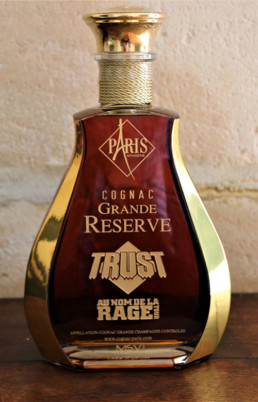
T2M Services: new perspectives with MSV
Frédéric Larour loves challenges and his life as a business leader fully illustrates this.
Of Breton origin, the entrepreneur holding a BTS Commercial Action moved to Charente in 1989 in order to introduce ADIA, a structure specializing in temporary work.
After 9 years in this structure, Frédéric Larour joined Access Services, a company that will become his own and that he will manage under the new name T2M Services.
The company offers, as its name suggests, the management of outsourced services for companies. Through this, it exercises several trades: contract or batch packaging, and logistics which goes from storage to the management of orders through the shipment of goods …
Visit the T2M Services website: www.t2m-logistique.fr
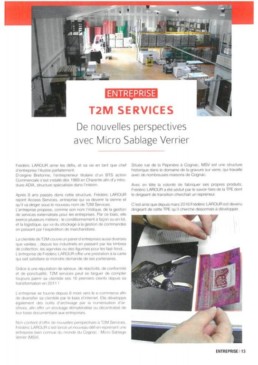
The History of Crystal
The MSV workshop engraves both glass and crystal. However, these two materials are very different and cannot be understood in the same way. Glassmaking has its subtleties, MSV reveals you its secrets !
The first transparent glass appeared in Venice in the 15th century and it was a major revolution. Previously, glassmakers had only succeeded in producing translucent glass with reflections oscillating between grayish yellow, green and blue. The raw material used was the source of the problem and it probably took countless attempts before finally achieving a perfectly transparent glass.
Venetian crystal and Bohemian crystal
In the middle of the 15th century, the famous glassmaker Angelo Barrovier (whom died in 1496) developed the first European translucent glass. If its purity arouses admiration, its fragility is very great. Anyway, such a feat becomes the source of a luxurious production that the greats of Italy and Europe are snapping up. There is no one up to the Pope who does not have a delicate carafe or bottle in Venetian crystallo on his table. The recipe makes the wealth of the city of the Doges. Venetian glassmaking has become so lucrative that the city’s political powers are protecting tooth and nail the secret of this perfectly transparent glass. No excuse is enough to allow a glassmaker to leave the city, it is too feared that he will divulge the secrets of the precious crystallo to strangers. The mistrust is such that the measures taken to defend the Venetian glass are more than crippling, going so far as to condemn to death the craftsmen disclosing outside the lagoon the arcana of the workshops.
It is that the flexibility of the work of Venetian glass allows all kinds of fantasy that ordinary glass did not yet allow. Glassmakers thus create new forms of bottles and decanters which can be engraved, enamelled or gilded according to the wishes of the sponsors. Of course, such an object of luxury and refinement arouses curiosity as well as lusts. All over Western Europe, glassmakers are trying to unravel the secret of the Venetian “crystal”. Despite threats from the authorities, some members of this profession – itinerant by nature because it must move according to the availability of the raw materials necessary for its art – will leave the Most Serene Republic and the glass-making secret will gradually cross the Alps.
La Bohême soon produced “Venice-style” glasses because one did not have the specific raw materials capable of imitating Italian glass perfectly. So one copies patterns and shapes as best as possible. However, the rich forest resources of this region allow in the 16th century the elaboration of a glass as hard and as heavy as rock crystal. With this translucent and very solid glass, Bohemia surpasses Venice by approaching even more the imitation of this mineral of a fascinating purity. Bohemian crystal is easily engraved and cut, so that masterpieces are made by great artists. Bohemian crystal glassware enjoys European renown. The princely courts tear themselves away and adorn their tables with these superb creations with baroque motifs.
The Real Crystal
The invention of lead crystal ushers in a new era in glassmaking. In the 17th century, the English were the first to transform glass into crystal and, if the recipe is still based on silica, a new ingredient will change everything. The use of lead makes it possible to give the glass a brilliance, a solidity and even a sound hitherto unmatched. The qualities of this new material are such that it differs greatly from glass. The first real crystal has just seen the light of day. And within a few years, the English crystal works surpassed both Venice and Bohemia.
Art works, lighting and even furniture in English crystal are exported from England to Europe, Russia, the East and India. At the end of the 18th century, the trade secret crossed the Channel and reached the north of France. The glassmakers of the Saint-Louis factory were the first to produce crystal pieces, followed in the 19th century by Baccarat and a few small glassworks in Île-de-France. The arts of the table, the development and refinement of gastronomy under the Empire gave a real rise to this crystal which magnifies tables and lights. Crystal glasses, decanters and bottles are first cut and engraved to appreciate the brilliance and purity of this material capable of reflecting light in a spectacular way. Joséphine de Beauharnais only uses crystal for her receptions and largely contributes to the reputation of French savoir-faire in this field.
From the second half of the 19th century, no table worthy of the name goes without crystal. Its refinement is such that nothing dethrones it even today. There is no bottle or decanter more luxurious than crystal ones. The famous wine and spirits houses want nothing else to showcase their finer ranges. This is why MSV calls on the most famous crystal makers for its high-end creations. Precious crystal bottles, decanters and flasks are embellished with custom engravings and carry your identity in the tradition of the greatest French houses. Can we help you for your project ? Contact us!
Collaboration Château Dauzac
The MSV de Cognac company warmly thanks Château Dauzac thanks to which it was once again able to demonstrate its know-how on prestigious bottles.
Do you know the Primate?
It is a new 27-liter format designed for passionate collectors and only offered by Château Dauzac.
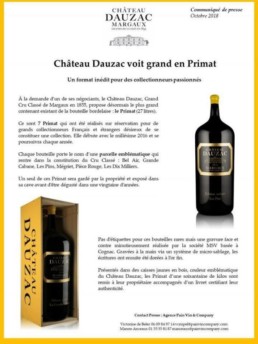
Segonzac University of eaux-de-vie calls on MSV
Talent association for the presentation of these three superb decanters and their boxes on the occasion of the day of March 23, 2018 which celebrated the 30 years of the promotion of the University of the eaux-de-vie of Segonzac!
- Elixir XO Project
- Exceptional cognac vintage 1988
- Crystal decanters from the Crystal Spirit collection
- Decor design by CD Design
- Crystal engraving by the MSV engraving workshop
- Wood box by Woodproject
- Box engraving by MB Serigraphie
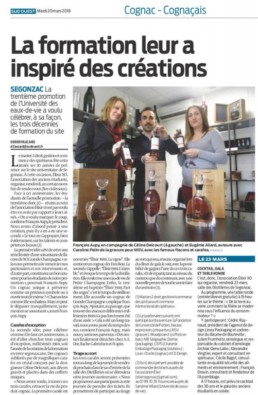
La Charente Libre talks about MSV
It is a star in the myriad of companies in the Spirit Valley, the center of trades around spirits that is taking root in Cognac. A star born in 2004 who almost died after its creator, Régis de Bony, died in December 2014. “MSV”, for Micro Sablage Verrier, is specialized in the sandblasting of glass, crystal, metal and wood, the bulk of its activity consisting of engraving decanters and bottles of cognac and prestige.
